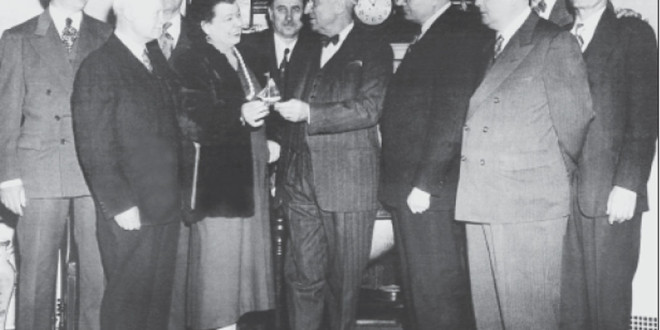by William T. Kvetkas, Jr.

IN THE LATE 1930S AS A TOTAL WAR IN EURO- pe appeared inevitable, Lithuania took the precautionary measure of depositing more than $1 million (a huge sum in those days) in a Washington, D.C. bank to sustain a continuing Lithuanian presence in its Embassy building on 16th Street. This was a judicious move and served well to help the Lithuanian cause. It gave Povilas Žadeikis, the Lithuanian representative from 1934 to 1957, a platform from which to keep the U.S. Congress and government officials apprised of the Lithuanian situation. As the war progressed, however, all U.S. efforts were aimed at prosecuting the war. Further, it became painfully evident that the cause of the Baltic States was dealt a severe blow when in 1945 at the Yalta Conference President Roosevelt, against Churchill’s advice, yielded to Stalin’s demands to place the three Baltic countries under the Soviet sphere of influence.
Meanwhile, as the war progressed and more particularly after the war, while there were freedom fighters in Lithuania struggling against oppression, many Lithuanian Americans worked continuously to free Lithuania and to help the Lithuanian people. Support came from all walks of life; lawyers, doctors, laborers, executives, politicians, religious organizations and non-religious organizations – all worked tirelessly. The efforts of all involved deserve due recognition, but many notable endeavors appear to have been lost through the passage of time.
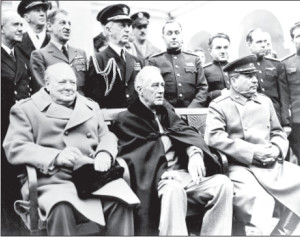
One event prominent on the world scene late in WW II was the San Francisco Conference. As the war drew to a close, representatives from allied nations gathered in San Francisco on April 25, 1945 to contemplate and decide upon the course to be taken after the final defeat of Germany and Japan. The decision to establish the United Nations was the most important accomplishment of the conference. The objective was to create an organization strong enough to prevent another World War.
Fifty nations had sent their most senior diplomats as delegates to the conference. In the existing state of world chaos, other countries, with tangible interests but unable to send delegates, were allowed to send observers. For instance, Poland had not yet set up its post-war government and was represented by a Polish American group. (Poland, however, signed the U.N. Charter later when its new government was formed.) Lithuania was to become part of the Soviet Union per the Yalta agreement and was allowed to send observers but not delegates to the conference.
The Lithuanian observers were selected from two Lithuanian American organizations. One of these, the Lithuanian American Congress established in 1941, was an organization created to aid escapees from Lithuania and to give assistance to the movement to free Lithuania. The President of the Congress at that time was Leonard Šimutis of Chicago and the Chairman of the Board of Trustees was William Kvetkas of Wilkes-Barre, Pennsylvania. Mr. Šimutis, President of the Executive Committee, and its members, Dr. Pius Grigaitis and Michael Vaidyla, chose Judge William J. Laukaitis of Baltimore and Mr. Kvetkas to be observers at the San Francisco Conference. Mary Kizis and Col. Kazys Grinius were designated as technical advisors to Judge Laukaitis and Mr. Kvetkas. The other Lithuanian organization also sent observers.
The main objective of the observers was to contact official delegates from the U.S. and from other countries, and convince them to support the Lithuanian cause. The group had contacted Sen. Arthur Vandenberg of Michigan, Sen. John Connolly of Texas, and various elements of the press but to no avail. At that point in time, there was no chance of overturning the decision at Yalta. The conference was a very high profile event but it resulted in no immediate benefit to Lithuania or Lithuanians.
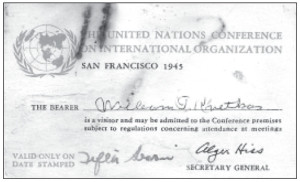
Other efforts, much lower in profile than the San Francisco Conference, met with some modest success. The Lithuanian American Congress held its first national convention in Pittsburgh where the principal speaker was Senator James J. Davis of Pennsylvania. The convention was a success and with the encouraging speech from Sen. Davis, the group decided to take the Lithuanian cause to Washington. This effort continued over a protracted period of time and was spearheaded by Mr. Šimutis, Mr. Kvetkas, and Mary Kizis. The three had met with Senator Francis Meyers, Congressman John F. Murphy and Congressman Daniel Flood, all from Pennsylvania. Flood, to the delight of all, made a speech on the floor of the House of Representatives the very next day, Feb. 16, commemorating Lithuanian Independence Day. Mary Kizis worked hard to make this an annual event.
The United States Congress was “being worked” thoroughly, but how about the Executive branch? Two prominent Lithuanian Americans from Chicago, Judge John J. Zuris and Al Kumskis arranged a meeting with President Harry S. Truman for the purpose of making certain that the President had an unfiltered explanation of the plight of Lithuania and Lithuanians. This meeting with President Truman took place at the White House in October 1946. Actually there also was a second meeting with Truman a few years later.
Many ethnic groups in addition to the Lithuanians were attempting to aid their people and help free the nations of their forbearers. By the mid 1940s these groups began holding meetings among themselves. An organization called the Fraternal Society Congress made up of many ethnic groups had held a meeting in Pittsburgh. After this particular meeting several attendees were riding the train to their respective homes: two “Poles,” a “Slovak,” and a “Lithuanian.” The “Lithuanian,” Mr. Kvetkas, observed that of the many Displaced Persons (DPs) in Europe, only Jewish DPs were being allowed into the U.S. The conversation continued and this small group decided to call another meeting, this time a committee comprised of select members of the Fraternal Society Congress. This second meeting also was held in Pittsburgh and the Chairman was Peter Jurchak, a Slovak. The participants decided to send a group with representation from all interested nationalities to Washington to petition the State Department on this subject. Mr. Šimutis, Dr. Grigaitis, Mr. Vaidyla and Mr. Kvetkas represented the Lithuanians. After the initial meeting in Washington and many weeks of lobbying, the State Department decided to let other nationalities including Lithuanians into this country on an experimental basis. This became a very successful program over the years. In one of his notes, Mr. Kvetkas later wrote, “Finally the Administration decided on an experiment and the Liths were chosen because they were a smaller number and their behavior was good. The DP Liths were the first to come followed by the Poles and others.”
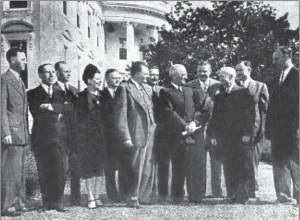
Lithuanian Americans also strongly supported other multi-national efforts like the United Nation’s Genocide Convention initiated in 1948. Another of the more prominent undertakings more closely related to Lithuania was called the “Kersten Resolution,” introduced by Congressman Charles J. Kersten of Wisconsin. Although the resolution addressed all of the Baltic States, the focus of the bill was mainly Lithuania. This resolution finally was passed as House Resolution 346 of the 83rd Congress, July 27, 1953, but as usual, getting it passed was not an easy task.
Anthony Olis of Chicago drafted the bill originally. It was a fine document, but inexplicably, the Chairman of the House Resolutions Committee, Congressman Leo E. Allen, repeatedly refused even to bring the resolution to his committee. This situation was particularly perplexing since Allen was from Illinois with its considerable Lithuanian population and Anthony Olis, a very prominent person, was from Chicago.
As the resolution languished in the Resolutions Committee, Mr. Šimutis, Dr. Grigaitis and Mr. Vaidyla visited Congressman Kersten in his office but were not successful in moving the resolution. This group contacted Mr. Kvetkas to see if he could muster support again from the Pennsylvania contingent. Mr. Kvetkas came to Washington and with the group visited Congressmen Edward Bonin, Luzerne County, Pennsylvania; Joseph Carrig, Lackawanna County; Ivor Fenton, Schuylkill County; and Hugh Scott of Philadelphia. These Congressmen fully supported the resolution, contacted Congressman Allen and thought they had his agreement to release the resolution. The Pennsylvania congressmen were livid when they heard later that Congressman Allen still chose not to release the Bill. They then contacted their Chairman, Congressman Kenneth F. Simpson, who in turn contacted Allen and demanded the release of the resolution. It worked.
On July 27, 1953 Congressman Hugh Scott of Pennsylvania stated on the floor of the House of Representatives: “Mr. Speaker, I call up House Resolution 346, and ask for its immediate consideration.” The Clerk read the resolution, as follows:
“Resolved, That there is hereby created a select committee to be composed of 7 Members of the House of Representatives to be appointed by the Speaker, one of whom he shall designate as chairman. Any vacancy…”
“The committee is authorized and directed to conduct a full and complete investigation and study of said seizure and forced “incorporation” of Lithuania, Latvia and Estonia by the Union of Soviet Socialist Republics and the treatment of the said Baltic peoples during and following the said seizure and “incorporation.”
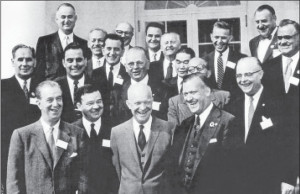
“The committee shall report to the House (or to the Clerk of the House if the House is not in session) as soon as is practicable during the present Congress the results of its investigation and study, together with such recommendations as it deems advisable.”
“For the purpose of carrying out this resolution of the committee… is authorized to sit… to hold such hearings, and to require by subpoena or otherwise, the attendance and testimony of such witnesses…”
The resolution had overwhelming support on the House floor and was adopted. Of particular note is the strength and sincerity of the comments of the congressmen in favor of the measure and it is well worth one’s time to read them. By 1953, however, the Cold War was the major focus of most Americans and the plight of the Baltics was just one piece of that complex mosaic. The Berlin Airlift was history and the Korean War was about over. Yet to come were the Cuban Missile Crisis, Vietnam, and many other crises. It was against this backdrop that efforts to focus upon Lithuania continued, but these actions mostly consisted of more visits to influential politicians. For instance Attorney John J. Grigalas, a good friend of the Kennedy clan, arranged a visit of prominent Lithuanian Americans to the White House to visit President John F. Kennedy.
Then in an interesting twist, as contrasted with ethnic groups using the power of politicians, politicians were becoming more attuned to the power of the ethnic groups. Both national political parties began courting the various ethnic organizations, including Lithuanian, in an attempt to garner votes. Although most of the ethnics did not contribute great sums of money to campaigns, they had their own newspapers which were a significant source of publicity, and in turn, possible votes. Money and publicity are two of the great engines of politics.
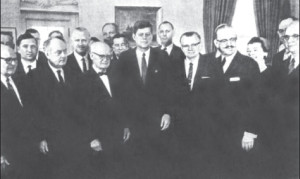
And so it went into the 1980s. The Lithuanian Embassy building in Washington had fallen into disrepair and Lithuanian Americans contributed funds to save it. Many Displaced Persons had been helped significantly, but otherwise most efforts had only intangible results – keeping officials focused on the plight of Lithuania and Lithuanians, but not resulting in significant U.S. action to assist Lithuania. Thanks to the successful prosecution of the Cold War, the Soviet Union went bankrupt and the Berlin Wall came down setting the stage in 1990 and 1991 for the brave and courageous patriots in Vilnius to reestablish an independent Lithuania. So ended another sordid chapter of repression in Lithuanian history.
 DRAUGAS NEWS Lithuanian World Wide News in English
DRAUGAS NEWS Lithuanian World Wide News in English
